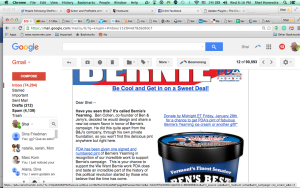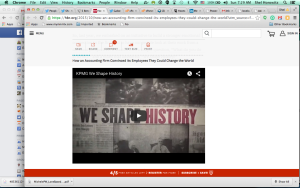Bernie and Brand Integrity


If you’re friends with me on Facebook, you already know I’m supporting Bernie Sanders in the Democratic primaries. And if you read this blog regularly, you know I’m both a long-time student of marketing and a long-time advocate of marketing with honesty and integrity.
In light of this, I received a mailing from one of the groups allied with the Sanders campaign, and immediately noticed some things I wanted to share.
- The product is totally in keeping with Bernie’s message, talking about the “1%” chocolate layer on top of the ice cream
- The video featuring Ben Cohen explaining the flavor to Jerry Greenfield, is hilarious, especially where he talks about breaking through the one percent barrier to spread the wealth (the chocolate) throughout the pint
- Most marketers, when faced with the opportunity to offer a single unique item, set a stratospheric price—but even with a total production run of just fifty, and only one being given to this organization, the price is only $50 (once again reinforcing the brand messaging)
- However, it’s something of a lottery; only one person gets the prize, but anyone who contributes $50 or more by the deadline gets to play
- There are also a number of less exclusive rewards—democratizing the lottery somewhat.
If you’d like to see the other prizes, or make a donation and enter the raffle (deadline is tomorrow), visit https://secure.actblue.com/contribute/page/wewantbernie
Disclaimer and disclosures: I am not involved in any way with organizing this promotion and don’t benefit financially. I have given money to the Sanders campaign and I’ve probably also given money to Progressive Democrats of America, the sponsoring organization.








